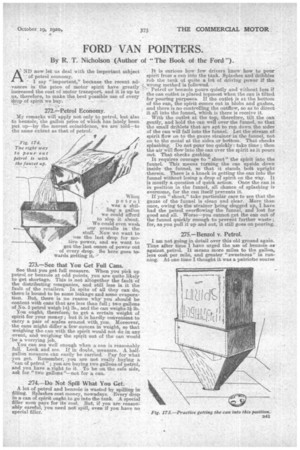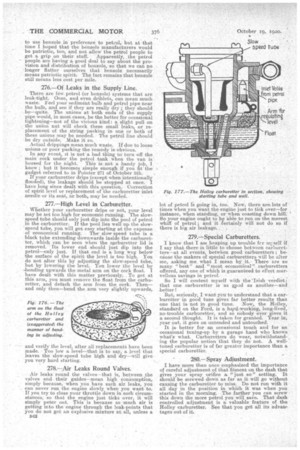FORD VAN POINTERS.
Page 73

Page 74

If you've noticed an error in this article please click here to report it so we can fix it.
By R. T. Nicholson (Author of "The Book of the Ford ").
A!. ND now Jet us deal with the important subject of petrol economy. ' I say "important," because the recent advances in the price of motor spirit have greatly increased the cost of motor transport, and it is up to us, therefore, to make the best possible use of every drop of spirit we buy. '
272.—Petrol Economy.
, My remarks will apply not only to petrol, but also to benzoic, the gallon price of which has lately been put up—lay the merest eoincidenee, we are told—to the same extent as that of petrol.
When petrol was a shilling a gallon we could afford to stop it. about. We could even wash our overalls in the stuff. Now we want to use the last drop for motive power, and we want to get the last ounce of power out of every drop. So here goes towards getting it.
273.—See that You Get Full Cans.
See' that you get full measure. When you pick up petrol or benzole at odd points, you axe quite likely to get shortage. This is not altogether the fault of the distributing companies, and still less is it the fault of the retailers. In spite of all they can do, there is bound to be some leakage and some evaporation. But, there is no reason why you should be content with cans that are less than full; two gallons of No. 3 petrol weigh 144 lb., and the can weighs 3/ lb. You ought, therefore, to get a certain weight of spirit for your money ; but it is hardly convenient to carry a pair of scales around with you. Moreover, the cans might differ a, few ounces in. weight, so that weighing the can with the spirit would not do in any event, and weighing the spirit out of the can would be a worrying job. You can see well enough when a can is reasonably full. Look and see. If in doubt, measure. A halfgallon measure can easily be carried. Pay for what you get. Remember, you are not really buying a, "can of petrol" ; you are buying two gallons of petrol, and you have a right to it. To be on. the safe side, ask for "two gallons "—not for a can. .
274.—Do Not Spill What You Get
A lot of petrol and henzole is wasted by spilling in filling. Splashes cost money, nowadays. Every drop in a can of spirit ought to go into the tank. A special filler soon pays for its cost. But, if you are reason:. ably careful, you need not spill, even if you have no special filler. It is curious how few drivers know how to pour spirit from a can into the tank. Splashes and dribbles rob the tank of quite a lot of driving power if the wrong method is followed. Petrol or benzole pours quietly and without fuse if • the can outlet is placed topmost when the can is tilted • for pouring purpose& If the outlet is at the bottom of the can, the spirit comes out in blobs and gushes, ; and there is no controlling the outflow, so as to direct it all into the funnel, which is there is receive it. With the outlet at the top, therefore, tilt the can • gently, and. hold the can well over the funnel, so that the small driblets that are apt to run down the sides Of the can will fall into the funnel. Let the stream of spirit flow on to the gauze strainer in the funnel, not on to the metal at the sides or bottom. That checks splashing. Do not pour too quickly: take time ; then the air'will flow into the can over the spirit as it pours out. That cheeks gushing.
It requires courage to shoot " 'the spirit into the funnel. This means turning the can upside down inside the funnel, so that it stands bolt upright therein. There is a knack in getting the can into the funnel without losing a. drop of spirit on the way. It is mostly a. question of quick action. Once the can is in position in the funnel, all chance of splashing is overcome, for the can itself pre-vents it.
If you "shoot," take particular care to see that the gauze of the funnel is clean and clear. More than once, owing to the strainer being clogged up, I have had the petrol overflowing the funnel, and lost for good and all. Worse—you cannot get the can out of the funnel quickly enough to prevent further waste ; for, as you pull it up and out, it still goes on pouring.
275.—Benzol v. Petrol.
I am not going in detail over this old ground again. Time after time I have urged the use of b-enzole as against petrol_ It means more miles to the gallon, less cost per mile, and greater "sweetness" in running: At one time I thought it was a patriotic course • to use benzole in preference to petsol, but at that time I hoped that the benzole manufacturers would be patriotic, too, and not allow the petrol people to get a grip on .their. stuff. Apparently, the petrol people are having a good deal to say about the provision and distribution of benzole,so that we can no longer flatter ourselves that benzole necessarily means patriotic spirit. The fact remains that benzole still means less cost per mile.
276.—Of Leaks in the Supply Line.
There are few petrol (or benzoic) systems that are leak-tight. Ooze, and even driblets, can mean much waste. Feel your sediment bulb and petrol pipe near the bulb, and see if they are really dry ; they should be—quite. The unions at both ends of the supply • pipe would, in most eases, be the better for occasional tightening—not of the vicious kind: a slight pull on the union nut will check these small leaks, or replacement of the string packing in one or both of these uninns may be needed. The petrol line should be dry outside. Make it so. Actual drippings mean much waste. If due to loose unions or poor packing the remedy is obvious. In any event, it is not a bad thing to turn off the main cock under the petrol tank when the -van is housed for the night. This is not a handy job, •I know ; but it becomes simple enough if you fit the s gadget referred to in Pointer 271 of October 5th.
If your carburetter drips (except when intentionally flooded), the leakage should be stopped at once. I have long since dealt with this question. Correction of spirit level or replacement of the carburetter inlet needle or its seat, or both, may be needed.
• 277.—High Level in Carburetter.
Whether your carburetter drips or not, your level may be set too high for economic running. The slowspeed tube should only just dip into the pool of petrol in the carburetter. If the pool lies well up the slowspeed tube, you will get easy starting at the expense of economical running. The slow speed tube is a black tube extending downwards inside the carburetter, which can be seen when the carburetter lid is removed. Its lower end should just dip into the petrol—only ju.st. If that end is a long way below the surface of the spirit the level is too high. You do not alter this by adjusting the slow-speed tube, but by lowering the level. You lower the level by • ipending upwards themetal arm on the cork float.
have dealt with this matter previously. To get at this arm, you must remove the float from the carburetter, and detach the arm from the cork. Then— and only then—bend the arm very slightly upwards, and verify the level, after all replacements have been made. Too low a level—that is to say, a level that leaves the slow-speed tube high and dry—will give you very hard starting.
278.—Air Leaks Round Valves.
Air leaks round the valves—that is, between the valves and their guides—mean high consumption, simply because, when you have such air leaks, you can never run the engine slowly when you want to. If you try to close your throttle down in such circumstances, so that the engine just ticks over, it will simply peter out. This is because so much air is getting into the engine through the leak-points that you do not get an explosive mixture at all, unless a D42
lot of petrol Is going in, too. Now, there are,lots of times when you want the engine just to tiek over—for instance, when standing, or when coasting down hill. " So your engine ought to be 'able to run on the merest. whiff of petrol ; and it tertainly will not do so if there is big air leakage.. ,
279.—Special Carburetters.
I know that I am heaping up trouble fcr myself if I say that there is little to choose between carburet-' ters—at all events, between good carburetters; because the makers of special carburetters will be after me, asking me what I mean by it. There are so many "best" arid "most economical" carburetters offered, any one of which is guaranteed to effect mar vellous savings in petrol. • So I will content myself with the 'Irish verdict: that one carburetter is as gpod as another—and better
But, seriously, I want you to understand that a carburetter in good tune gives far better results than one that is not in good tune. Now, the Holley, standard on the Ford, is a hard-working, long-lived, no-trouble carburetter2 and so nobody ever gives it a second thought. It is taken for granted. Year in, year out, it goes on untended and untouched.
It is better for an occasional touch and for an• occasional tuning-up by a, garage hand who knows what's what. Carburetters do wear, notwithstanding the popular notion that they do not. A welltuned carburetter is of far greater importance than a special carburetter. .
280.—Spray Adjustment.
I have more than once emphasized the importance of careful adjustment of that fitment on the dash that gives your spray orifice a "just so" setting. It should be screwed down as far as it will go without causing the carburetter to miss. Do not run with it all day in the position in which it was when you started in the morning. The farther you can screw this down the more petrol you will Rave. That dash controlled adjustment is a valuable feature of the Holley carburetter. See that you get all its advantages out of it.












































































